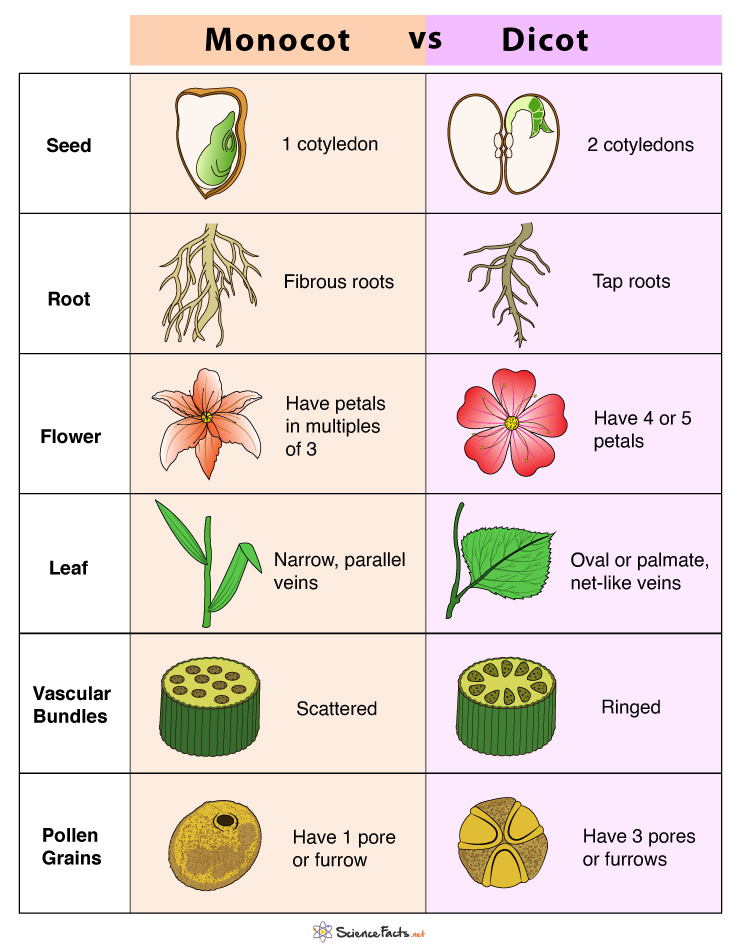Monocot vs. Dicot
Historically flowering plants (angiosperms) are classified into two broad types or groups – monocotyledons or monocots and dicotyledons or dicots.
The classification of angiosperms was first published by John Ray in 1682 and later by the botanist Antoine Laurent de Jussieu in 1789.
Monocots and Dicots
Monocots are flowering plants having seeds with a single cotyledon or embryonic leaf. There are as many as 60,000 plant species found worldwide. The orchids (Family: Orchidaceae) and the grasses (Family: Poaceae) form the largest and the second most abundant group, respectively. All monocots share a common evolutionary history, thus are a monophyletic group.
Dicots are flowering plants having seeds with two cotyledons or embryonic leaves. They are the largest group within angiosperms consisting of about 200,000 species. Unlike monocots, dicots are not plants arising from a single ancestor but have evolved from different lineages. Thus dicots are paraphyletic.
What Is the Difference between Monocot and Dicot
Monocots and dicots differ in four distinct structural features: seeds, leaves, stems, roots, and flowers.
However, the difference starts from the very beginning of their life cycle in the form of a seed. Within the seed lies the embryo or the baby plant. At the start of their life cycle, the difference in their embryo leads each plant to develop vast differences.
The key differences between them are presented below in tabular form.
| Basis | Monocots | Dicots |
|---|---|---|
| 1. Examples | Palms, grasses, orchids such as tulips, corn, wheat, barley, and sugarcane | Green peas, almonds, sunflower, rose, apples, and grapes |
| 2. Embryo | Has one cotyledonForms a single leaf that grows as a long and narrow structure at the time of germination | Has two cotyledonsForms two seeds that develop into different shapes |
| 3. Vascular System | Bundles of vascular tissue are scattered throughout the stem with no particular arrangementHas no cortex | Bundles of vascular tissue are arranged in the form of a ring.Divided into a cortex and stele |
| 4. Leaf Venation | Parallel | Reticulated (branched) |
| 5. Types of Leaves | Isobilateral | Dorsiventral |
| 6. Stomata in Leaves | Mostly found on both the upper and the lower surface (amphistomatous)Arranged in highly ordered rows | Some are found only on one surface (epistomatous) Arranged haphazardly |
| 7. Bulliform Cells | Present | Absent |
| 8. Flowers | Petals are formed in multiples of three In some plants, calyx and corolla are undifferentiated | Petals are formed in multiples of four or five Calyx and corolla are differentiated |
| 9. Stem | Mostly herbaceous, but some have arboraceous stemsUnbranched and fleshy Vascular bundles are scattered in no fixed pattern. Mostly lack a lateral meristem or cambiumCambium, when present, is not differentiated into cortex or stellar regionsEpidermal hairs are absent | Either herbaceous or arboraceous stemsBranched and hardVascular bundles are arranged in concentric circlesContains a lateral meristem or cambium Cambium is differentiated into the stellar regions and cortex Epidermal hairs are present |
| 10. Secondary Growth | Do not exhibit secondary growth due to the absence of cambium | Secondary growth occurs due to the presence of cambium |
| 11. Root System | Has an adventitious or fibrous root system | Mostly has a tap root system. Some dicots have an adventitious root system |
| 12. Secondary Growth | Mostly present | Absent |
| 13. Seed Germination | Hypogeal | Hypogeal or epigeal |
| 14. Endosperm | Always present and is usually large | May not be present and is mostly small |
| 15. Fruit | Trilocular | Pentalocular |
| 16. Pollen | Contain a single furrow or pore | Contents three furrows or pores |
| 17. Mode of Pollination | By wind | By insects or animals |
For further explanation of these differences, learn more about the differences in monocot and dicot roots and monocot and dicot stems to compare and contrast them.
Similarities
- Angiosperms or flowering plants
- Vascular plants using xylem and phloem to move water and nutrients throughout the plant
- Have stamens with four (two pairs) of pollen sacs, and the carpel is closed.
- Male gametophyte is made of three cells, and female gametophyte consists of seven cells with eight nuclei.
-
References
Article was last reviewed on Friday, February 3, 2023





Super